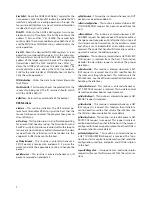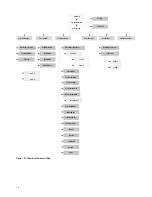
12
CheckWheel
– This function checks whether the proper
sequence of commands have been issued by the host
to enable the wheel of the mouse. The sequence is three
consecutive setting rate commands of 200, 100 and 80
reports per second.
send_1
– sends a PS/2 1 bit
send_0
– sends a PS/2 0 bit
GetBit
– receives a PS/2 bit from the host
Interrupt Service Routines (ISR)
The CY7C63743-PXC features 12 different sources of
interrupts. There are only four ISRs implemented in this
application. If an interrupt is enabled and the conditions
for the interrupts are met, the microcontroller will gener-
ate an interrupt. Upon servicing the interrupt, the hard-
ware will fi rst disable all interrupts by clearing the Global
Interrupt Enable bit. This is followed by an automatic
CALL instruction to the ROM address of the interrupt
being serviced in the Interrupt Vector. The instruction in
the Interrupt Vector is typically a JMP instruction to the
Interrupt Service Routine (ISR). A RETI or RET instruction
at the end of the ISR brings the program counter (PC)
back to the location prior to the interrupt (POR and USB
Bus Reset are exceptions).
DualMain
– When power is fi rst applied to the CY7C63743-
PXC, a Power On Reset (POR) occurs; the microcontroller
starts executing code from address 0x00. This is a JMP
instruction to the
DualMain
routine. This routine initial-
izes the program stack pointer (PSP), data stack pointer
(DSP), ram variables, and the GPIO pins. This routine calls
GetMouseType
which returns the interface of the mouse.
If a USB interface is detected, the program jumps to
the
usbMain
loop. Otherwise, the program goes to the
ps2Main
loop.
DualUsbBusReset_ps2Error
– The USB-PS2 Interrupt Mode bit
in the USB Status and Control Register is defaulted to
“0”, or USB mode. This indicates that the USB Bus Reset
interrupt will be generated if the SE0 condition (D+ and
D- are both LOW) exists for 256us. This ISR enables the
USB Device Address, sets up the endpoint modes and
jumps to
usbMain
for the USB initialization.
Dual1msTimer
– This ISR reads the current status of the
buttons. Therefore, every one millisecond the button
state is updated; the button status information will be
used by the
ProcessButtons
function at a later time. This
ISR maintains the
dualInterface1ms
counter variable
which is used as a 1ms timing reference in other parts
of the program. This routine also handles the entrance
or exit from suspend. The mouse will prepare to enter
a suspend (low power) state if there is no bus activity in
3ms. If the mouse is confi gured for remote wakeup, the
Bus Reset and wakeup interrupts are enabled prior to sus-
pending the chip. The program then enters a suspended
state, and will wake at least as often as the wakeup timer
interrupts or as a result of the USB Bus Reset interrupt.
Each time the chip wakes up due to the wake up timer
interrupt, the state of the buttons is examined by the
GetButtons
function. If a change in the button state has
occurred, the mouse will generate a resume signal to
the host and exit the ISR. If the device is not enabled
for remote wakeup, only the USB bus reset interrupt is
enabled, and the part is suspended. Only a Bus Reset can
wake up the chip. If the resume was due to bus activity,
the fi rmware returns to the main loop. If the resume was
due to a button press, a K state is driven upstream for 14
milliseconds prior to returning to the main loop. Moving
the mouse will not wake the suspended system.
DualUsbEndpoint0_ps2Error
– This ISR is entered upon receiv-
ing an Endpoint 0 interrupt. Endpoint 0 interrupts occur
during the Setup, data, and status phases of a control
transfer. This ISR handler jumps to the proper routine to
handle one of these phases.
DualUsbEndpoint1_ps2Error
– This ISR is entered upon re-
ceiving an Endpoint 1 interrupt. If the ACK bit is set,
indicating that a mouse packet was just transmitted
to the host successfully, the SIE automatically sets the
endpoint mode to NAK_IN mode, and the data toggle
bit is fl ipped for the next transaction. The data toggle bit
should never be toggled if the interrupt was a result of a
NAK transaction.






































